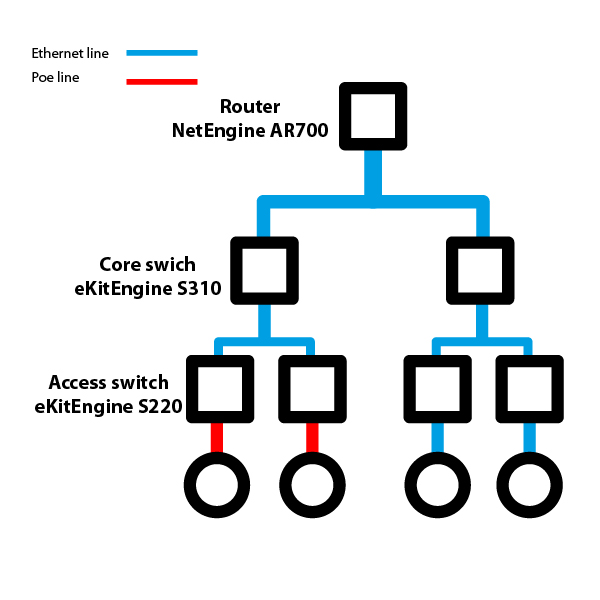-
€



The Huawei S220-48T4S is a managed switch from the eKitEngine series. It is equipped with 48 gigabit Ethernet ports (10/100/1000 Mbps) and 4 SFP slots (1 Gbps). It supports Layer 2 management, including protocols such as STP (STP/RSTP/MSTP) and ERPS (Ethernet Ring Protection Switching). It provides high network security, supports various types of authentication (based on MAC address or 802.1X), and is protected against various external attacks. You can manage the device using the Web UI, CLI, or SNMP. Additionally, it supports cloud management and the Huawei eKit application. The S220-48T4S has a built-in AC power supply, with a maximum power consumption of 44.3 W. It utilizes active cooling with intelligent fan speed adjustment. The device is suitable as an advanced access switch in locations where you don't need PoE or as the main switch in smaller networks.
48x gigabit Ethernet, 4x SFP
The switch is equipped with 48 gigabit Ethernet ports (10/100/1000 Mbps) and 4 SFP slots (1 Gbps). It has a switching capacity of 104 Gbps and a packet forwarding rate of 77 Mpps. With one of the SFP slots, you can establish connections over very long distances using fiber optic cables.


Layer 2 management
The device provides numerous Layer 2 management features, including VLAN support, multicast handling (IGMP Snooping), Quality of Service (QoS) functions, and Access Control Lists (ACLs). It supports Spanning Tree protocols (STP/RSTP/MSTP) as well as the modern standard ERPS (Ethernet Ring Protection Switching) defined in the ITU-T G.8032 standard.
The switch provides essential network security measures. It protects against DoS attacks such as SYN flood, Land, Smurf, and ICMP flood. Additionally, it includes protection against attacks targeting users, such as DHCP server attacks, IP/MAC spoofing, DHCP request flood, and DHCP CHADDR attacks.
Management is conducted through the graphical Web interface, CLI, or using SNMP (v1, v2c, v3) / SSHv2.0. Devices from the S220 series can also be managed in the cloud, and in this case, you can additionally use the Huawei eKit app.
Usage
The primary use of the S220-48T4X is as an access switch in locations where PoE is not required. It is best suited for networks based on eKitEngine solutions, as using devices from the same series simplifies configuration and subsequent management. You can connect devices such as personal computers (PCs) or printers to the device. The S220-48T4X is an excellent solution for various types of office networks.

Specifications
| Huawei S220-48T4S | |
| Switching Capacity | 104 Gb/s |
| Packet forwarding | 77 Mp/s |
| Fixed port |
48x gigabit Ethernet 10/100/1000 Mb/s 4x SFP (1 Gb/s) |
| Chassis dimensions (H x W x D) | 43.6 mm x 442 mm x 220 mm |
| Chassis height | 1U |
| Weight | 3,59 kg |
| Power module type | Built-in AC power module |
| Rated voltage | 100 - 240 V AC, 50/60 Hz |
| Maximum voltage | 90 - 29 V AC, 45/65 Hz |
| Maximum power consumption | 44,3 W |
| Noise |
Sound power at normal temperature: 46.6 dB (A) Sound power at high temperature: 54.3 dB (A) |
| Long-term operating temperature | –5°C to +50°C |
| Storage temperature | –40°C to +70°C |
| Relative humidity | 5% to 95% (noncondensing) |
| Service port surge protection | Common mode: ±10 kV |
| Power port surge protection | Differential mode: ±6 kV Common mode: ±6 kV |
| Heat dissipation mode | Air cooling, intelligent fan speed adjustment |
| Service features | |
|---|---|
| MAC address table | Automatic MAC address learning and aging 16K MAC address entries at maximum Static, dynamic, and blackhole MAC address entries Source MAC address filtering Limitation on the number of MAC addresses learned by an interface |
| VLAN features | 4094 VLANs Voice VLAN VLAN assignment based on MAC addresses, protocols, IP subnets, policies, and ports VLAN stacking |
| Ethernet switching | G.8032 Ethernet Ring Protection Switching (ERPS) STP (IEEE 802.1d), RSTP (IEEE 802.1w), and MSTP (IEEE 802.1s) BPDU protection, root protection, and loop protection BPDU tunnel |
| Multicast | IGMP v1 / v2 / v3 oraz IGMP v1 / v2 / v3 snooping |
| Reliability |
LACP (Link Aggregation Control Protocol) LLDP (Link Layer Discovery Protocol) |
| QoS/ACL | Traffic rate limiting in the inbound and outbound directions of a port Packet redirection Port-based traffic policing and two-rate three-color CAR Eight queues on each port DRR, SP, and DRR+SP queue scheduling algorithms Re-marking of 802.1p and DSCP priorities for packets Packet filtering on Layer 2 to Layer 4, filtering out invalid frames based on the source MAC address, destination MAC address, source IP address, destination IP address, TCP/UDP source/destination port number, protocol, or VLAN |
| Security features | Hierarchical user management and password protection Defense against DoS, ARP, and ICMP attacks Binding of the IP address, MAC address, port ID, and VLAN ID Port isolation, port security, and sticky MAC Blackhole MAC address entries Limitation on the number of learned MAC addresses IEEE 802.1X authentication and limit on the number of users on an interface Multiple authentication modes including AAA, RADIUS, HWTACACS and NAC authentication SSH v2.0 HTTPS CPU protection Blacklist and whitelist DHCP client and DHCP snooping |
| Management and maintenance | Cloud management based on NETCONF/YANG Virtual cable test (VCT) Remote configuration and maintenance by using Telnet SNMPv1/v2/v3 Web system-based management HTTPS LLDP/LLDP-MED System logs and alarms based on severities IEEE 802.3az: Energy Efficient Ethernet (EEE) Port mirroring Deployment through the registration query center |






 Polski
Polski English
English Italiano
Italiano Español
Español Čeština
Čeština Српски
Српски Deutsch
Deutsch Ελληνικά
Ελληνικά Slovenský
Slovenský




